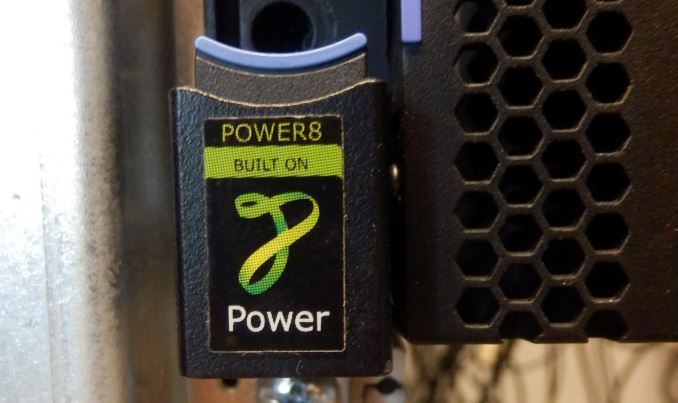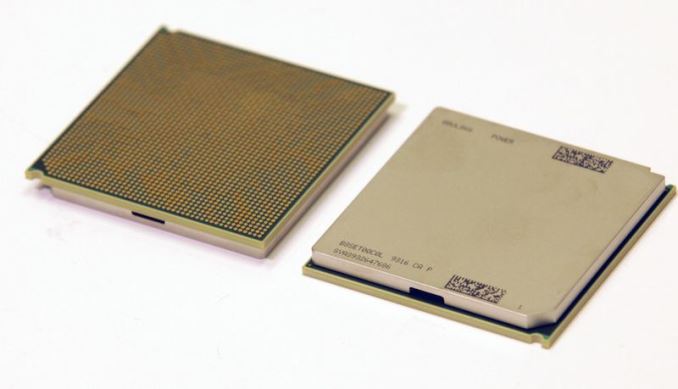The IBM POWER8 Review: Challenging the Intel Xeon
by Johan De Gelas on November 6, 2015 8:00 AM EST- Posted in
- IT Computing
- CPUs
- Enterprise
- Enterprise CPUs
- IBM
- POWER
- POWER8
Comparing Benchmarks: AT vs IBM
Before we close things out, let's spend a moment summarizing our results and comparing the performance we saw to the kind of performance advantages that IBM advertises POWER8 is capable of.
From a high level perspective, the S822L is more expensive and consumes a lot more power than a comparable Xeon system.
With limited optimization and with the current Ubuntu 15.04, the performance-per-watt ratio favors Intel even more as the POWER8 barely outperforms the very efficient 120W TDP Xeons. So there is no denying that the Intel systems offer a superior performance/watt ratio.
However, it would be unfair to base our judgement on our first attempt as we have to admit this our first real attempt to benchmark and test the POWER8 platform. It is very likely that we will manage to extract quite a bit more performance out of the system on our second attempt. IBM POWER8 also has a big advantage in memory bandwidth. But we did not manage to port OpenFOAM to the POWER platform, probably the most likely candidate for leveraging that advantage.
We are less convinced that the POWER8 platform has a huge "raw CPU compute advantage," contrary to what for example IBM's SPECJBB (85% faster ) and SAP (29% faster) results seem to suggest.
For example, IBM's own SPECjEnterprise®2010 benchmarking shows that:
- Two Xeon E5-2697 v3, 14 cores at 2.6-3.1 GHz score 19282
- Two POWER8, 12 cores at 3.5-3.8 GHz score 22543
SAP is "low IPC" (hard to run many instructions in parallel in one thread) software that benefits much from low latency caches. The massive L3-cache (12-cores, 96 MB) and huge thread count are probably giving the IBM POWER8 the edge. The RAM bandwidth also helps, but in a lesser degree. IBM clearly built POWER8 with this kind of software in mind. We had individual threadcount intensive benchmarks (LZMA decompression) and L3-cache sensitive benchmarks (ElasticSearch), but t o be fair to IBM, none of our benchmarks leveraged the three strongest points (threadcount, L3-cache size and memory bandwidth) all at once like SAP.
SPECJBB2013 has recently been discontinued as it was not reliable enough. We tend to trust the jEnterprise test a lot more. In any case, the best POWER8 has a 17% advantage there.
Considering that the POWER8 inside that S824 has 20% more cores and a 3% higher clockspeed, our 3.4 GHz 10-core CPU would probably be slightly behind the Xeon E5-2697 v3. We found out that the 10-core POWER8 is slightly faster than Xeon E5-2695 v3. The Xeon E5-2695 v3 is very similar to the E5-2697 v3, it is just running at a 10% lower clockspeed (All core turbo: 2.8GHz vs 3.1GHz). So all in all, our benchmarks seems to be close to the official benchmarks, albeit slightly lower.
Closing Thoughts: A Mix of Xeon "E5" and "E7"
So let's sum things up. The IBM S822L is definitely not a good choice for those looking to lower their energy bills or operate in a location with limited cooling. The pricing of the CDIMMs causes it to be more expensive than a comparable Xeon E5 based server. However, you get something in return: the CDIMMs should offer higher reliability and are more similar to the memory subsystem of the E7 than the E5. Also, PCIe adapters are hot-pluggable on the S822L and can be replaced without bringing down the system. With most Xeon E5 systems, only disks, fans and PSU are hot-pluggable.
In a number of ways then, the S822L is more a competitor to dual Xeon E7 systems than it is to dual Xeon E5 systems. In fact, a dual Xeon E7 server consumes in the 600-700W range, and in that scenario the power usage of S822L (700-800W) does not seem outrageous anymore.
The extra reliability is definitely a bonus when running real time data analytics or virtualization. A failing memory chip may cost a lot when you running fifty virtual machines on top of a server. Even in some HPC or batch data analytics applications where you have to wait for hours for a certain result that is being computed in an enormous amount of memory, the cost savings of being able to survive a failing memory chip might be considerable.
One more thing: for those who need full control, the fact that every layer in the software stack is open makes the S822L very attractive. For now, the available "OpenCompute" Xeon servers that are also "open" seem to mostly density optimized servers and the openess seems limited on several levels. Rackspace felt that the current OpenCompute servers are not "open enough", and went for OpenPOWER servers instead. In all those markets, the S822L is very interesting alternative to the dual Xeon E5 servers.
Ultimately however, the performance-per-dollar Xeon E5 competitors will most likely be OpenPOWER third party servers. Those servers do not use CDIMMS, but regular RDIMMs. Other components such as disks, networkcards and PSUs will probably be cheaper but potentially also slightly less reliable.
All in all, the arrival of OpenPOWER servers is much more exciting than most of us anticipated. Although the IBM POWER8 servers can not beat the performance/watt ratio of the Xeon, we now have a server processor that is not only cheaper than Intel's best Xeons, but that can also keep up with them. Combine that with the fact that IBM has lined up POWER8+ for next year and a whole range of server vendors is building their own POWER8 based servers, and we have a lot to look forward to!












146 Comments
View All Comments
joegee - Thursday, November 19, 2015 - link
It was an awesome community. I learned so much from everyone. I remember the days when we'd write pages arguing whether AMD's new 64 bit extension to x86 was truly 64 bit. The discussions could be heated, but they were seldom rude. I wish there were something similar today. :/Kevin G - Saturday, November 7, 2015 - link
Aces brings back memories for me as well even though I mainly lurked there.A solid chunk of that group have moved over to RWT.
joegee - Thursday, November 19, 2015 - link
What is RWT?psychobriggsy - Friday, November 6, 2015 - link
Get back to Aces Hardware you!JohanAnandtech - Saturday, November 7, 2015 - link
Like Ryan said, I have been working 11 years at Anand. In other words, it is great working at Anandtech. AT is one of the few tech sites out there that still values deep analysis and allows the editors to take the time to delve deep.joegee - Friday, November 6, 2015 - link
And still writing as well as you ever did! Keep up the good work, Johan!rrossi - Saturday, November 7, 2015 - link
Dear Johan nice article. Did u ever consider sparse system solving (with preconditioning) as a sensitive benchmark? It is a crucial stage of most scientific applications and it is a bandwidth limited operation with a high degree of parallelism. It would be definitely interesting to see how the power 8 fares on such a test. If you are interested I think I could provide a pointer to a simple benchmark (to be compiled). If you feel it may be interesting just drop me an email.JohanAnandtech - Saturday, November 7, 2015 - link
Interested... mail me, I don't have your mail. See the author link on top of the article.Ian Cutress - Saturday, November 7, 2015 - link
I'd also like to be pointed to such a benchmark for workstation style tests on x86. Please email ian@anandtech.com with info :)MartinT - Friday, November 6, 2015 - link
Johan's been with Anandtech for more than a decade, and has been publishing on the subject since the late 90s.But I very much second your "Niiiiice!," as reading his name always reminds me of the old days over at aceshardware, and I'm always looking forward to his insights!